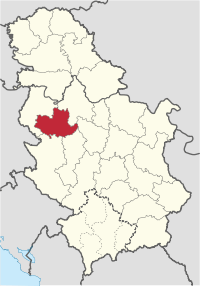Kolubara District
The Kolubara District (Serbian: Колубарски округ / Kolubarski okrug, pronounced [kɔlǔbarskiː ôkruːɡ]) is one of eight administrative districts of Šumadija and Western Serbia. It occupies the central part of western Serbia. According to the 2011 census results, it has a population of 174,513 inhabitants. The administrative center of the Kolubara District is Valjevo, on the banks of the Kolubara River.
Kolubara District Колубарски округ Kolubarski okrug | |
|---|---|
District of Serbia | |
 Location of the Kolubara District within Serbia | |
| Coordinates: 44°16′N 19°53′E | |
| Country | |
| Region | Šumadija and Western Serbia |
| Administrative center | Valjevo |
| Government | |
| • Commissioner | Goran Milivojević (as of 16 July 2015) |
| • Predecessor | Vladimir Petrović (14 November 2013 - May 2015) |
| Area | |
| • Total | 2,474 km2 (955 sq mi) |
| Population (2011 census) | |
| • Total | 174,513 |
| • Density | 70.5/km2 (183/sq mi) |
| ISO 3166 code | RS-09 |
| Municipalities | 5 and 1 city |
| Settlements | 218 |
| - Cities and towns | 7 |
| - Villages | 211 |
| Website | www |
Municipalities
The district encompasses the municipalities of:
Demographics
| Year | Pop. | ±% p.a. |
|---|---|---|
| 1948 | 192,572 | — |
| 1953 | 201,411 | +0.90% |
| 1961 | 202,630 | +0.08% |
| 1971 | 202,990 | +0.02% |
| 1981 | 205,094 | +0.10% |
| 1991 | 200,560 | −0.22% |
| 2002 | 192,204 | −0.39% |
| 2011 | 174,513 | −1.07% |
| Source: [1] | ||
According to the last official census done in 2011, the Kolubara District has 174,513 inhabitants. Ethnic composition of the district:[2]
| Ethnic group | Population | % |
|---|---|---|
| Serbs | 166,325 | 95.31% |
| Roma | 4,045 | 2.32% |
| Montenegrins | 215 | 0.12% |
| Yugoslavs | 161 | 0.09% |
| Macedonians | 133 | 0.08% |
| Croats | 120 | 0.07% |
| Others | 3,514 | 2.01% |
| Total | 174,513 |
Culture
This region is distinguished for its cultural-historic monuments: the Muselim's Palace, a typical example of the Turkish architecture built in the thirteenth century, the Tower of the Nenadovic Family, built in 1813 by Duke Janko, the church of Valjevo originating from 1838 which is a rare example of monumental classicistic style building in Serbia.
Tourism
The major tourism resorts in the district are: the Divčibare and the Vrujci Spa.
References
- "2011 Census of Population, Households and Dwellings in the Republic of Serbia" (PDF). stat.gov.rs. Statistical Office of the Republic of Serbia. Archived from the original (PDF) on 14 July 2014. Retrieved 11 January 2017.
- "Попис становништва, домаћинстава и станова 2011. у Републици Србији" (PDF). stat.gov.rs. Republički zavod za statistiku. Archived from the original (PDF) on 11 August 2014. Retrieved 15 December 2016.
Note: All official material made by Government of Serbia is public by law. Information was taken from {{url|https://web.archive.org/web/20090221052324/http://www.srbija.gov.rs/%7D%7D.%27%27